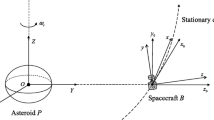Abstract
Dual-spin or gyrostat satellites subject to gravitational torques can adopt an infinite number of possible equilibria obtained by adjusting the magnitude and direction of the rotor angular momentum within the satellite. This paper seeks to answer the question, which of these equilibria is best — and best is chosen here to mean most stable in the sense that the energy required to perturb the orientation by any prescribed amount is maximized, i.e. the smallest eigenvalue of the Hessian matrix of the dynamic potential energy is maximized. Using this criterion, it is shown that the conventional configuration for dual-spin satellites with the angular momentum of the rotor, the spacecraft principal axis of maximum moment of inertia, and the perpendicular to the orbital plane coincident is not always the best orientation. The optimal configuration is shown to have the minimum moment of inertia always aligned with the local vertical, but the principal axis of maximum moment of inertia, shifts from the perpendicular to the orbital plane to lying in-plane as the angular momentum of the rotor is increased from zero (corresponding to a rigid gravity gradient satellite) to some sufficiently large value which is determined as a function of parameters. For angular momentum greater than this value, global optimality is established analytically, and otherwise local optimality is proved analytically with global optimality demonstrated numerically.
Similar content being viewed by others
References
Kane, T. R. and Mingori, D. L.: 1965, ‘Effect of a Rotor on the Attitude Stability of a Satellite in Circular Orbit’,AIAA J. 3, 938.
Longman, R. W. and Roberson, R. E.: 1969, ‘General Solution for the Equilibria of Orbiting Gyrostats Subject to Gravitational Torques’,J. of the Astronautical Sciences 16, 49.
Longman, R. W.: 1972, ‘Stability Analysis of all Possible Equilibria for Gyrostat Satellites under Gravitational Torques’,AIAA J. 10 800.
Longman, R. W.: 1969, ‘The Equilibria of Orbiting Gyrostats with Internal Angular Momenta along Principal Axes’,Proceedings of the Symposium on Gravity Gradient Attitude Stabilization.
Longman, R. W.: 1973, ‘Stable Tumbling Motions of a Dual-Spin Satellite Subject to Gravitational Torques’,AIAA J. 11, 916.
Longman, R. W.: 1969,A Generalized Approach to Gravity-Gradient Stabilization of Gyrostat Satellites, The Rand Corporation, RM-5921-PR.
Roberson, R. E.: 1968, ‘Equilibria of Orbiting Gyrostats’,J. of the Astronautical Sciences 15, 242.
Roberson, R. E.: 1968, ‘Stability of Orbiting Gyrostats in the Elementary Cases’,Ingenieur-Archiv 39, 242.
Longman, R. W.: 1971, ‘Gravity Gradient Stabilization of Gyrostat Satellites with Rotor Axes in Principal Planes’,Celest. Mech. 3, 169.
Longman, R. W.: 1975, ‘Attitude Equilibria and Stability of Arbitrary Gyrostat Satellites under Gravitational Torques’,J. of British Interplanetary Society 28, 38.
Hadley, G.: 1962,Linear Programming, Addison-Wesley Publishing Company, Inc.
Author information
Authors and Affiliations
Rights and permissions
About this article
Cite this article
Li, T., Longman, R.W. Optimal configurations for dual-spin satellites subject to gravitational torques. Celestial Mechanics 33, 319–336 (1984). https://doi.org/10.1007/BF01241047
Received:
Revised:
Issue Date:
DOI: https://doi.org/10.1007/BF01241047



